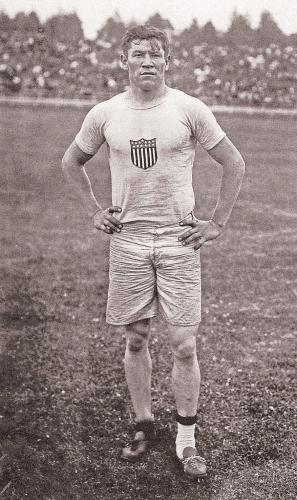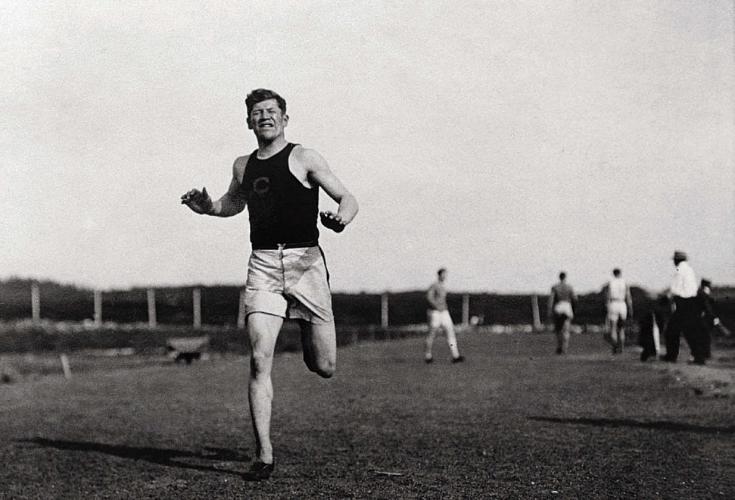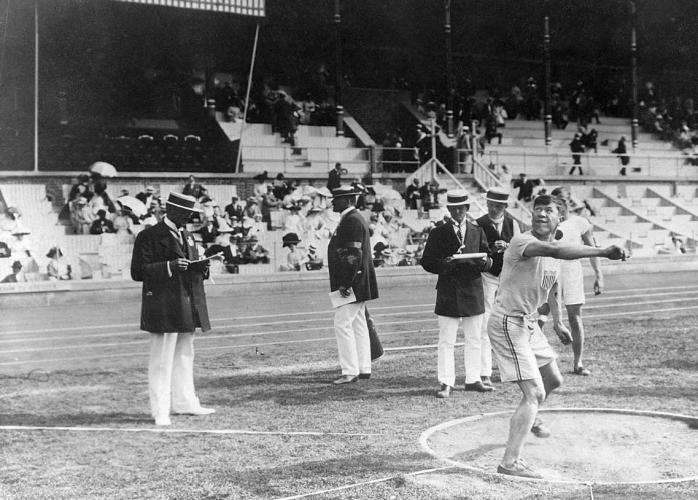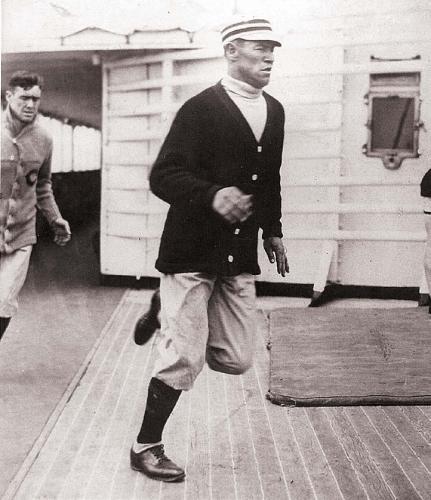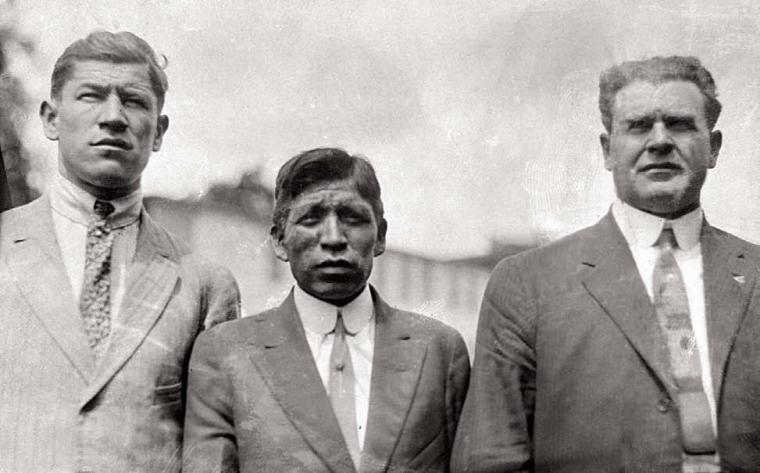Just seven months after James Francis Thorpe stood at the peak of Olympic glory, it all came crashing down. And a major Indian institution fell with him.
Thorpe had caught fire at the 1912 Stockholm Games, winning Olympic gold medals in the all-around pentathlon and decathlon in a performance never since equaled. He had amply earned the praise from King Gustav V, “Sir, you are now the greatest athlete in the world.”
Back home, after a tiring round of parades and celebrations, he led the Carlisle Indian Industrial School football team through a triumphant season, culminating in its dramatic and well savored victory over Army.
Then, during the Carlisle team’s post-season demonstration tour in western Massachusetts, a chance remark by one of Thorpe’s former coaches gave a local reporter the scoop of a lifetime. There are different versions of the conversation, but the coach, Charles C. A. Clancy, manager of the Winston-Salem baseball team of the semi-pro Eastern Carolina Association, revealed that Thorpe had played two summers in the league, in 1909 and 1910. Thorpe had earned $5 a game.
The reporter, Roy Johnson, spent several months developing the story and printed it in the Worcester (Mass.) Telegram in early January, 1913. It lay there several weeks, and Clancy denied it. But on January 25, the story bloomed into national headlines with the news that formal charges had been filed against Thorpe by the New England Association of the Amateur Athletic Union. A New York Tribune story, in particular, was based on an interview with the AAU national secretary, James E. Sullivan.
Even before an investigation, Sullivan had decided on a course of action. “If Thorpe is found guilty,” he told the Tribune, “the trophies will have to be returned and his records erased from the books.”
The next day, Thorpe signed a letter admitting the charge. (Thorpe’s close friend Gus Welch later told a Congessional investigator that the letter was in fact drafted by the Carlisle coach Glenn Scobey “Pop” Warner and Carlisle Superintendent Moses Friedman.) “I did not play for the money there was in it,” said the letter, “because my property brings me in enough money to live on, but because I like to play ball. I was not wise in the ways of the world and did not realize this was wrong, and that it would make me a professional in track sports, although I learned from the other players that it would be better for me not to let anyone know that I was playing and for that reason I never told anyone at the school about it until today.” Thorpe said that several of his teammates were college athletes playing under assumed names but that he played under his own name.
“I hope I will be excused,” he continued, “because of the fact that I was simply an Indian school boy and did not know all about such things.”
Sullivan rejected the plea and stripped Thorpe of his amateur status, then controlled by the AAU. He also directed the AAU national committee to inform the Olympic organizers at Stockholm and the International Olympic Committee that Thorpe had forfeited his Olympic medals.
But the letter that the AAU sent to the IOC reflected some misgivings. “It seems strange that men having knowledge of Thorpe’s professional conduct did not at such time, for the honor of their country come forward and place in the hands of the American Committee such information as they had,” the national committee members wrote. While the committee condemned Thorpe, it added, “They also feel that those who knew of his professional acts are deserving of still greater censure for their silence.”
This affair caused some puzzlement in Stockholm. The official Olympic report reveals uncertainty about the proper procedure, since, as it emerged only 70 years later, the deadline for challenging the results of the Games had long passed. But Warner presented them with a fait accompli. In Thorpe’s absence, the coach took the medals and two other Olympic trophies from Thorpe’s house and shipped them back to Stockholm.
This hasty action, and the not so veiled comments in the AAU letter, suggest that more was afoot than Thorpe’s misjudgment. Warner, and possibly Sullivan himself, were well placed to know about Thorpe’s stint in the Carolina league. (Sullivan, the most powerful figure of the time in amateur athletics, was also by profession the editor of Spalding’s Athletic Almanacs, the most comprehensive sports record of the time.) The harsh action against Thorpe looks also like a case of damage control and cover-up.
It also set a precedent for an extreme interpretation of amateurism, which was not at all settled at the time and which now has been completely abandoned. This version held that an Olympic competitor should not have received any compensation at any time for any sport, even one unrelated to his event, or for a line of work related to sports. The great Native Hawaiian swimmer and surfer George Freeth, mentor of Duke Kahanamoku, was excluded from the 1912 Olympics because he worked as a lifeguard. This principle would seem quaint now, if it were not so vicious.
This version of amateurism was said to be modeled on English upper-class sportsmanship, and that is the tip-off. The English rules were overtly designed to keep lower and middle classes from competing with the aristocracy. The Henley Royal Regatta explicitly excluded anyone who “ is or has been by trade or employment for wages a mechanic, artisan or labourer”; it barred entry, for instance, to the American Olympic champion sculler John B. Kelly, Sr. father of the actress Grace Kelly, future Princess of Monaco. (Kelly went on to win three gold medals, in the 1920 and 1924 Olympics, even though he had previously played professional football.) Historians would say that this doctrine of amateurism was a case of status anxiety, a means of protecting privilege against a rising class challenge. It’s significant that the one group of professionals that were allowed to compete in their Olympic sport were fencing masters, because they were by definition “gentlemen .”
When the newspaper scandal broke around Thorpe, the unwashed masses remained strongly on his side. Many editorials defended him and ridiculed the AAU. “All aspiring athletes will do well to ponder this action of the American Athletic Union,” wrote the Philadelphia Times sarcastically, “and not play croquet, ping-pong, tiddly winks, or button-button-who’s-got-the-button for compensation.”Thorpe left Carlisle and turned pro athlete with a vengeance. As a major box office draw, he helped put professional football on its feet. He served as first president of the forerunner of the National Football League. Thorpe was a main reason pro sports are now so deeply a part of American life.
Backlash at Carlisle
Although Thorpe himself remained stoic and rarely complained about the loss of his Olympic medals, his friends were furious. They turned their rage on the Carlisle officials that they felt had failed to defend the school’s greatest star. The results were devastating to Carlisle.
Gus Welch (Ojibwe), Thorpe’s roommate and best man at his wedding, gathered more than 200 signatures on a student petition urging the Commissioner of Indian Affairs to investigate misconduct in the school’s administration and athletic department. The results might have exceeded Welch’s expectations. The Bureau of Indian Affairs dispatched an investigator, E.B. Linnen, who wrote a thorough, and thoroughly hostile, report. A special joint investigation committee of Congress descended unannounced on the campus and held a week of public hearings on location.
The two efforts dredged up everything that could be dredged up, from the laundry to a shortage of fl our to Carlisle Superintendent Moses Friedman’s alleged double-billing for train tickets and his failure to prevent students from making anti-Jewish remarks about him. But the prime target was the athletic program.
Carlisle, in Linnen’s version, was the prototype of a football team with a school attached. “Football and athletics have dominated said school,” the inspector wrote. “[A]ll other departments have been made to be subservient thereto.” Following the model of some Ivy League schools, the athletic department was organized as a separate corporation, with Coach Warner as president. The extensive national touring of the team had been highly profi table. Between 1907 and 1913, by Linnen’s figures, the athletic fund had netted $223,789.83.
The heads of the teaching departments resented the priority given football and secondarily, the marching band. The players complained about Warner’s abusive language, mild as it might seem by the standards of today’s subscription cable networks. Student suspicions of corruption, however, were largely unfounded. Linnen admitted that the funds were mostly used for the school’s benefit. Football receipts paid for the erecting and refurbishing of fi ve buildings, including a separate dormitory for athletes, the print shop and the art department. Warner himself received an annual salary of $4,000 plus free housing, higher compensation than the school’s superintendent. The average annual salary at the time was $800.
Linnen emphasized, however, that it was a violation of federal law for the athletic corporation to keep control of its profits; all earnings were supposed to be turned over to the school.
The most startling accusation, however, was that the student players themselves had received payments. Linnen listed several large checks used to pay cash to football players. He presented Exhibit G “showing the amount of money paid each football player during the years 1907-08 out of the two checks aggregating $9,233.
“I also call your attention to the fact that out of the $9,233 paid to football players during the years 1907-08, James Thorpe, a professional, received the sum of $500.”
Some scholars through the years have cited this statement to justify the IOC action against Thorpe. But these payments might not have been what they seemed to Linnen. Testifying under oath to the Congressional committee, Warner denied categorically that he paid salaries to his players.
Chairman Joe T. Robinson, the U.S. Senator from Arkansas, asked, “What do they receive that other pupils do not get?”
Warner answered, “Well, at the close of the season the boys are given a $25 suit of clothes and a $25 overcoat; that is, the first team. And the first team also get a souvenir of some kind.”
Either Warner had lied to Congress, a heinous offense to the Republic, or Linnen had misinterpreted the financial records. The committee seemed to accept Warner’s answer. Its members volunteered that the school paid for regular athletic equipment and all team travel expenses. Defenders of Thorpe suggest that these expenses might account for the checks cited by Linnen. A definitive answer is not easily available, however. Exhibit G was not printed with the committee report.
Whatever the facts, the investigations eviscerated the athletic program. Its surplus funds, totaling $25,640.08, were turned over to the school superintendent, and Warner left Carlisle. The football team was a shadow, losing the rest of its schedule by lopsided scores. Although the school lingered on until August 1918, when the Army took it back for war uses, the noted Carlisle scholar Tom Benjey dates its true demise to the visit of the Congressional investigating committee. And although students and faculty had many grievances, it can fairly be said that the retraction of Thorpe’s medals was the fatal blow to morale.
The Medals Return
Thorpe himself remained loyal to Carlisle. He visited the campus when his stint with the New York Giants brought him nearby, and he invited Superintendent Friedman to participate in his wedding (to which, foreshadowing the Kardashians, he sold the movie rights). The hurt of losing the medals remained deeply repressed, revealed only in private moments.
The medals themselves reverted to the Scandinavian runners-up in both events. They wound up in Scandinavian sports museums, from which, over the years, they were both stolen. True to Sullivan’s words, Thorpe’s name was expunged from the record books. His score in the decathlon remained unbeaten but unacknowledged for decades.
But Thorpe’s family and friends kept petitioning the IOC to restore his rightful honors. The campaign only intensified after Thorpe’s death in 1953. It encountered stubborn resistance, however, from a person with a vested interest in making Thorpe an unperson. From 1952 to 1972, the president of the IOC was the American Avery Brundage. By strange coincidence, Brundage was not only Thorpe’s teammate in the 1912 Olympics, he competed against Thorpe in the pentathlon and decathlon, finishing sixth in the pentathlon. With Thorpe removed from the amateur ranks, Brundage became national all-around champion, a standing that he later admitted helped open doors to his construction business.
A self-righteous, vindictive sort, Brundage was typecast for the role of villain in the Thorpe affair. He has been blamed, more or less implausibly, for everything from ratting out Thorpe to the IOC to stealing his track shoes at Stockholm. One of Thorpe’s leading biographers, Robert Wheeler, doubts that Brundage was involved in the original disqualification, but Brundage more than made up for it in later life by his curt dismissal of petitions for Thorpe’s reinstatement, some of them organized by Thorpe’s daughter, Grace, and by Wheeler himself. To be fair to Brundage, he made enemies across the board, including entire countries, by his rigid rules on amateurism. His retirement from the IOC in 1972, after a particularly insensitive reaction to the killings of Israeli athletes at the Munich Olympics, brought a sigh of relief in the athletic world. The next year the AAU voted to reinstate Thorpe’s amateur status.
The contest continued to change in Thorpe’s favor at the end of the 1970s, when Congress intervened to take Olympic athletics out of the hands of the AAU and vested it in the United States Olympic Committee. The legislation specifically allowed corporate sponsorship for Olympic athletes; the Olympic skier Suzy Chaffee, an adviser on the bill and active supporter of Native participation in the Olympics, lobbied for the provision to allow access to the Games for competitors from all income levels.
But the tipping point came, as Wheeler recounts it, with a stroke of luck and good research. He and his wife Florence Ridlon, a Ph. D. in sociology, had long asked the IOC for a copy of the rules for the 1912 Olympics and had been told that none could be found. In July 1982, Ridlon was looking through the sports archives of the Library of Congress when she spotted a thin pamphlet with an orange cover that had fallen behind a shelf. When she pulled it out, it was a copy of the Swedish rules and regulations for the 1912 Olympics. “She sat on the floor and cried,” Wheeler said.
There, in black and white was Rule 13: objections to the qualification of a competitor “must be accompanied by a deposit of 20 Swedish Kronor and received by the Swedish Olympic Committee before the lapse of 30 days from the distribution of prizes.” The letter from the AAU disqualifying Thorpe had arrived well past the deadline (and there is no evidence it included 20 kronor). The retraction of Thorpe’s medals not only was unfair, it was illegal.
American sports officials, notably USOC president William Simon, were already lobbying for Thorpe, and with this evidence, the IOC caved in. On October 13, 1982, it voted to restore Thorpe’s honors. But nothing has been simple in this affair. The original medals were missing, so the IOC proposed striking commemorative medallions. Thorpe’s supporters said that wouldn’t do, and through friends in Sweden located the molds for the original medals. New medals were struck from the original molds, not of gold, which had been discontinued for the medals after 1912, but of the modern silver alloy with gold plating. IOC President Juan Samaranch presented the new medals to Thorpe’s children in Los Angeles in 1983, as part of the build-up to the 1984 Los Angeles Olympics.
Thorpe’s daughters Gail and Grace presented the medals to the Oklahoma Historical Society, which put them on display in the State Capitol. But the drama continued. A security guard stole the medals, and after they were recovered, the state decided they would be safer in the Oklahoma Historical Society. Through special arrangement with the Historical Society and Thorpe’s surviving sons William and Richard, the medals will now go on display under tight security at the National Museum of the American Indian from May 24 through the July Fourth weekend as part of the special exhibit Best in the World: Native Athletes in the Olympics. The Thorpe family, working with Meridian Sports Management, then plans to have them displayed at the London Olympics at the end of July.
The reputation of Jim Thorpe, “the greatest athlete in the world,” will finally be restored to the peak of Olympic glory.
Again, in spite of Jim Thorpe’s effortless grace as an athlete, nothing about his memory has been easy. Another conflict is nearing a head about the resting place of his body. During his interment in Oklahoma in 1953, his last wife Patricia interrupted the traditional Sac and Fox ceremonies and removed his coffin in protest of the state government’s failure to honor a promise to fund a memorial. Impressed by the local development efforts of the towns of Mauch Chunk and East Mauch Chunk in eastern Pennsylvania, she offered them the honor of maintaining his final resting place as a tourist attraction. The towns renamed themselves Jim Thorpe, PA, and now maintain a shrine and museum for him.
Thorpe’s children have lobbied for years for the return of his body to Sac and Fox territory. His surviving sons finally brought a lawsuit under the Native American Graves Protection and Repatriation Act; the suit was recently allowed to move forward by a federal judge. The cause has become a second-generation effort for the Wheeler family; their son Rob Wheeler, a student at Massachusetts Institute of Technology, has opened a website jimthorperestinpeace.com for an online petition to support the return. The website has received testimonials of support from 82 Indian nations.

